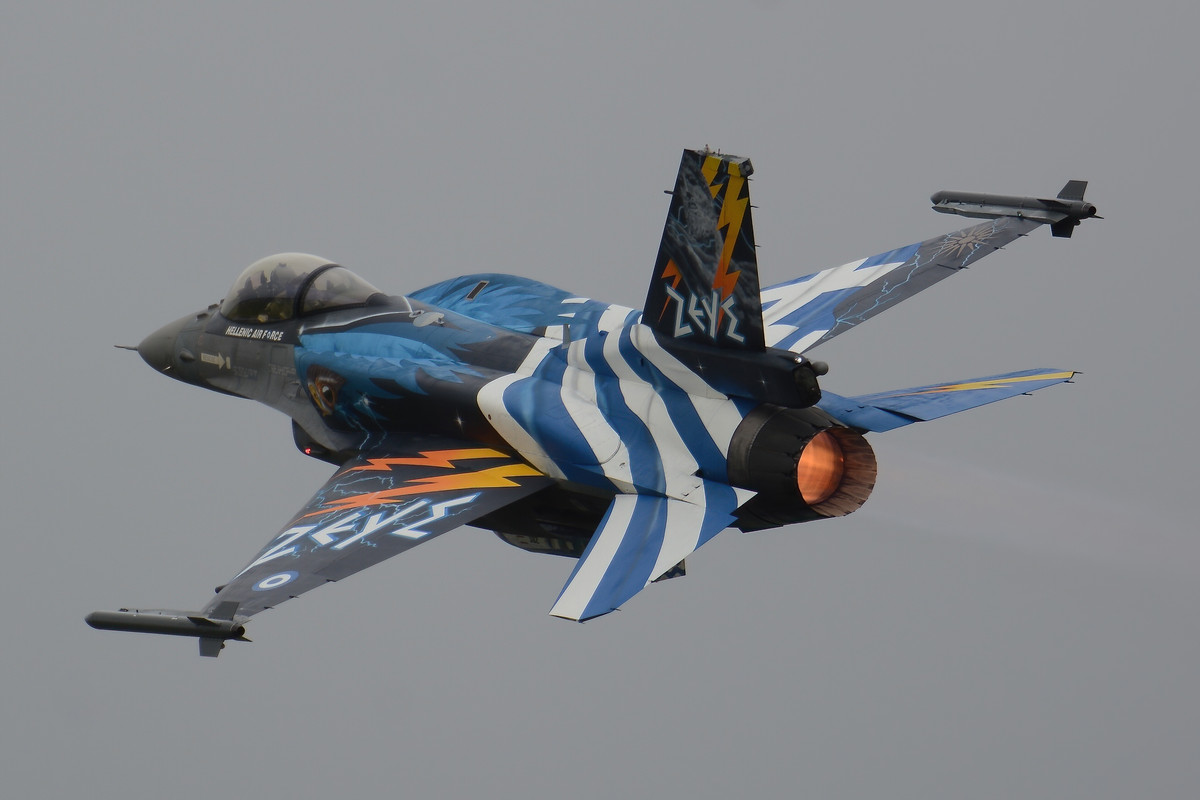
Zeus Demo Team
F-16 demonstration team “ZEUS”
The Zeus Demo Team is an aerial demonstration team of the Hellenic Air Force, flying the F-16 Fighting Falcon to showcase the capabilities of the HAF. The team’s mission includes boosting morale within the military, inspiring recruitment among Greece’s youth, strengthening public trust in the Air Force, and retaining high-quality personnel. The name "Zeus," drawn from the king of the Olympian gods in Greek mythology, reflects strength, authority, and Greece’s rich cultural heritage.
Formed as part of the HAF’s long-standing tradition of aerial demonstration teams, the Zeus Demo Team emerged following intensive training with the United States Air Force’s Viper West F-16 Demo Team. The team performs a variety of aerial maneuvers, adapting to weather conditions with different show profiles—such as high, low, and flat shows—highlighting the agility of the F-16 and the exceptional skill of its pilots.
The team flies the F-16C Block 52+ aircraft, equipped with Conformal Fuel Tanks, a configuration that distinguishes them as the first F-16 demo team to use this setup. These operational jets, finished in the standard Aegean Gray Scheme, underscore the HAF’s readiness for action. All performances adhere to strict international flight safety standards, demonstrating the professionalism and high standards of the Hellenic Air Force.
About the F-16
The General Dynamics F-16 Fighting Falcon, commonly known as the F-16, is a single-engine multirole fighter aircraft originally developed by General Dynamics (now Lockheed Martin) for the United States Air Force. Its origins trace back to the Lightweight Fighter (LWF) program in the early 1970s, initiated by the U.S. Air Force to develop a cost-effective, agile, and versatile aircraft to complement heavier fighters like the F-15 Eagle. The F-16’s design was selected in 1972 following a fly-off competition against the Northrop YF-17, with its first flight occurring on January 20, 1974, at Edwards Air Force Base. Officially entering service in August 1978, the F-16 quickly gained a reputation for its innovative fly-by-wire flight control system, exceptional maneuverability, and adaptability, earning it the nickname "Viper" among pilots.
Throughout its development, the F-16 evolved from a lightweight day fighter into a highly capable all-weather multirole aircraft. Early models, such as the F-16A/B Block 1 through 15, focused on air-to-air combat with limited ground attack capabilities. However, subsequent upgrades, including the F-16C/D variants introduced in the mid-1980s, incorporated advanced radar systems like the AN/APG-68, precision-guided munitions, and enhanced avionics, broadening its mission scope to include air-to-ground strikes, suppression of enemy air defenses, and reconnaissance. The F-16 saw extensive combat use, beginning with Israel’s Operation Opera in 1981, and later in conflicts such as the Gulf War, the Balkans, and operations in Iraq and Afghanistan. Over 4,600 F-16s have been produced, with the aircraft exported to more than 25 countries, making it one of the most widely used fighter jets in the world.
The F-16’s continuous evolution has kept it relevant into the 21st century. The latest variant, the F-16V (Viper), introduced in 2012, features an Active Electronically Scanned Array (AESA) radar, modernized cockpit systems, and improved weaponry, ensuring its competitiveness against newer aircraft. Production shifted to Greenville, South Carolina, in 2019, after decades in Fort Worth, Texas, reflecting ongoing demand from international customers. Despite the rise of fifth-generation fighters like the F-35, the F-16 remains a cornerstone of many air forces due to its affordability, reliability, and upgrade potential, with plans for its use extending beyond 2040 in some nations.
Specifications
Crew
1 F-16C / 2 F-16D
Length
49 ft 5 in (15.06 m)
Wingspan
32 ft 8 in (9.96 m)
Height
16 ft (4.9 m)
Max Speed
Mach 2.05 (2,178 km/h; 1,353 mph; 1,176 kn)
Combat Range
295 nmi (339 mi, 546 km)
Service Ceiling
50,000 ft (15,000 m)
Thrust/weight
1.095
F-16 in the Hellenic Air Forcet
The Hellenic Air Force (HAF) of Greece has been a significant operator of the F-16 since the late 1980s, integrating the aircraft into its defense strategy amid regional tensions, particularly with Turkey. Greece’s acquisition began with the Peace Xenia I program in 1989, under which it received 40 F-16C/D Block 30 aircraft, delivered between 1989 and 1990. This marked a major modernization effort for the HAF, replacing older aircraft like the F-5 and A-7. Subsequent purchases under Peace Xenia II (40 F-16C/D Block 50, delivered 1997–1998), Peace Xenia III (60 F-16C/D Block 52+, delivered 2003–2004), and Peace Xenia IV (30 F-16C/D Block 52+ Advanced, delivered 2009–2010) expanded the fleet to 154 aircraft, making the F-16 the backbone of Greece’s air combat capability.
In Greek service, the F-16 has been pivotal in maintaining air superiority over the Aegean Sea, where Greece and Turkey frequently engage in mock dogfights due to longstanding disputes over airspace and territorial waters. The aircraft have been equipped with advanced systems tailored to HAF needs, including conformal fuel tanks, the Link 16 datalink, and a mix of American and European weaponry, such as the IRIS-T missile. The HAF’s F-16s have also participated in NATO exercises and multinational operations, showcasing their interoperability and combat readiness. A notable milestone came in 2015 when Greece began upgrading 84 of its F-16s to the F-16V standard, a $1.2 billion program with Lockheed Martin, enhancing their avionics and radar to counter modern threats.
The F-16’s role in the HAF reflects Greece’s strategic priorities and its reliance on U.S. military support within NATO. The upgrade to the F-16V, expected to complete by 2027, ensures the fleet’s relevance amid regional challenges, including Turkey’s growing military capabilities. While the HAF has expressed interest in fifth-generation fighters like the F-35, budget constraints and the F-16’s proven performance suggest it will remain a key asset for decades, balancing deterrence and operational flexibility in a geopolitically volatile region.
Did You Know?
- The F-16 was the first fighter aircraft to use a fly-by-wire flight control system, replacing traditional mechanical linkages with electronic controls for unmatched agility.
- The F-16's bubble canopy isn’t just for looks—it gives pilots a rare 360-degree field of view, a feature few other fighters can match.
- Despite being a single-engine jet, the F-16 can pull 9G turns, a feat that tests both the aircraft’s structure and the pilot’s endurance.
- The F-16 has moonlighted as a NASA testbed, helping develop cutting-edge flight control systems beyond its combat role.
- Over 100,000 combat missions have been flown by F-16s since 1978, a staggering number that highlights its durability across decades of conflict.
Test Your Knowledge
1. In what year did the F-16 first take flight?




















